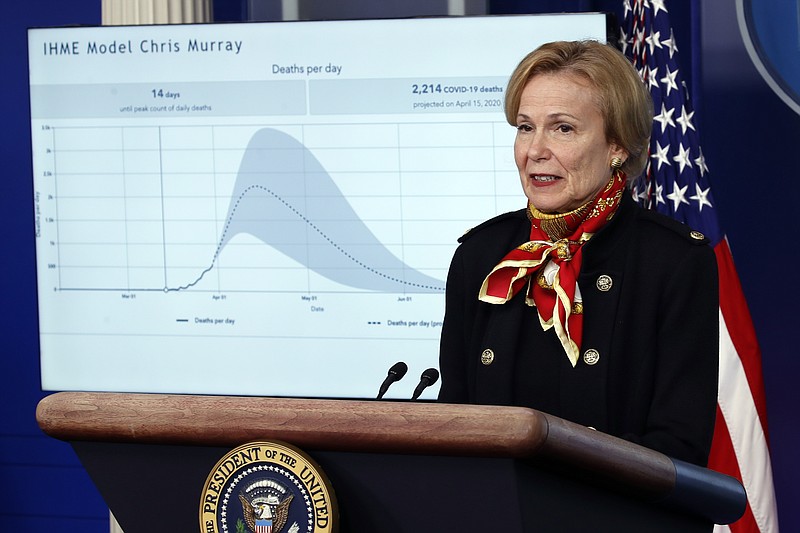Journalists are generally really bad at math. We're good with words. Not so good with math. Some of us joke that it's why we're journalists. We love research, asking questions and getting answers, but numbers too often defy us.
Yet we don't have to be mathematicians or rocket scientists to get this:
In the wee hours of Friday, the United States had more than 6,000 coronavirus deaths and by Friday evening seemed well on its way to 10,000 deaths.
Just the day before on Thursday, the coordinator of Trump's coronavirus task force, Deborah Birx, stood before the nation in a briefing with a slide showing a high-arcing COVID-19 mountain - the worst-case scenario: 1.5 million to 2.2 million deaths if Americans and the government did nothing to stop the virus.
For the numbers-challenged among us, let's put it in words. Six thousand early Friday and possibly upward of two million in coming months.
Birx also pointed to another smaller mountain within the taller one. The "flattened" curve, she said, represented the fewer deaths forecast if we all embrace social distancing. How many fewer? A still imposing number of 100,000 to 240,000 deaths, came the answer.
Tennessee and Georgia governors finally late Thursday put down orders demanding rather than just asking and trusting the experts' social distancing advice. Just hours before, Chattanooga Mayor Andy Berke signed a shelter-in-place order for city residents.
To prepare for a potential spike in local coronavirus cases, Hamilton County Mayor Jim Coppinger said the county is executing surge planning with several state and federal agencies to accommodate an influx in patients needing hospital care. Within minutes of Coppinger's announcement, Gov. Lee identified the Chattanooga Convention Center as a designated surge location - a temporary hospital for COVID-19 patients who don't require intensive medical care.
This is both horrifying and reassuring.
Yet doubts remain about the White House numbers underlying all this activity.
Consider the Washington Post blockbuster story posted online Friday evening headlined "Experts and Trump's advisers doubt White House's 240,000 coronavirus deaths estimate."
Here's the report's beginning: "Leading disease forecasters, whose research the White House used to conclude 100,000 to 240,000 people will die nationwide from the coronavirus, were mystified when they saw the administration's projection this week. The experts said they don't challenge the numbers' validity but that they don't know how the White House arrived at them. White House officials have refused to explain how they generated the figure - a death toll bigger than the United States suffered in the Vietnam War or the 9/11 terrorist attacks. They have not provided the underlying data so others can assess its reliability or provided long-term strategies to lower that death count."
If that leaves you scratching your head, you might be a journalist. Or you might just deduce, as we do, that once again the White House is just making some of this stuff up as its occupant stumbles along.
Here are some other learned doubters.
* Anthony S. Fauci, director of the National Institute of Allergy and Infectious Diseases and - today, at least - a top coronavirus adviser to the president, told fellow members of the White House coronavirus task force that there are too many variables at play in the pandemic to make the models reliable: "I've looked at all the models. I've spent a lot of time on the models. They don't tell you anything. You can't really rely upon models."
* Robert Redfield, director of the Centers for Disease Control and Prevention, and the vice president's office have similarly voiced doubts about the projections' accuracy, according to three White House officials who spoke to The Post on the condition of anonymity because they were not authorized to speak publicly.
* Jeffrey Shaman, a Columbia University epidemiologist whose models were cited by the White House, said his own work on the pandemic doesn't go far enough into the future to make fatality predictions like those forecast by the White House.
* Other experts told The Post that the White House didn't even explain the time period the death estimate supposedly captures - the coming few months, or the year-plus it will take to find and distribute a vaccine.
Yet as Trump trotted out the government's projected fatality count, he said it was based on data "that has been, I think, brilliantly put together."
Are we saying the concern and the actions are bogus? Absolutely not. People are out of work, some are sick and too many are dying.
If throwing together a dozen forecasts and making a best guess (the upshot of Birx's explanation of the numbers process during a briefing earlier in the week) helped motivate our governors and leaders to act with more urgency, we'll consider it well worthwhile.
But that doesn't lessen the need for real leadership at the top. We've never needed it more than now.
